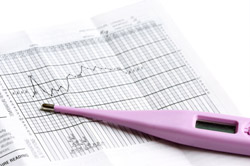Signs of Ovulation
Knowing your body's signs of ovulation will help you to know your body's fertility schedule. You will understand your body and yourself better, which is what life is all about, right?
Increased Body Temperature

This is probably the most well known of the signs of ovulation. It's pretty easy to do, and it doesn't have to cost much.
Because of the increased progesterone level in your body at the time of ovulation, your body temperature increases during the 14 days (approximately) of ovulation. On the day that you ovulate, your temperature gets a bit lower, and then the day after you ovulate, it will go up to about one degree. It will stay there for about 14 days, and then it will drop back down during your non-ovulatory range for the next 14 days. See this site for more information.
The difference in temperature is very subtle- only about 1 degree. This is why it's important to use a basal body thermometer which is specifically calibrated to read temperatures to the nearest tenth of a degree. You use these right when you wake up in the morning.
A basal body thermometer cost between $10-$20. You can get them online or at a drug store.
Cervical Mucus
Another sign of ovulation is the consistency of your cervical mucus.
Cervical mucus is dry, and you have little of it during the first 14 days of your cycle. It becomes more creamy when you near ovulation, and it becomes clear and stretchy during ovulation.
Hormones
Your hormone levels change as you move through your cycle. You get a boost of estrogen and progesterone when you ovulate, and that level lowers just before you menstruate.
Checking your level of Lutenizing Hormone (or LH) is another way to track your cycle. LH is a hormone that will increase for a couple days just before you ovulate. You can track this hormone level by testing your urine with ovulation kits which costs between $20-$80 a month.
Cervical Position
This sign of ovulation is a bit harder to detect. It is also not for the faint of heart!
Your cervix will be higher and feel softer during ovulation than it is during the rest of your cycle.
Check it by inserting two fingers into your vagina and pushing your fingers back until you feel something that is harder than the rest of your vagina.
In order to chart this factor, you need to become familiar with the position of your cervix throughout your cycle. You need to get into the same squatting position each time that you check, and gradually, you will feel the differences in your body.
In the Mood?
On the day that your ovaries release an egg, you may be feeling a bit romantic.
This happens because our androgen levels (sex hormones) rise during this time. Isn't that amazing? During the time that we are most fertile, we feel like having sex. I guess that it's Mother Nature's way of making sure that we continue to have babies!
Crazy Emotions?
Along with feeling a sexual surge, you may notice that you are crying for reasons that seem ridiculous to you. For many women, this change in emotion is another sign of ovulation.
Tender Breasts & Headaches
If your breasts get very tender for a few days in your cycle, it is most likely just before your ovulate. The same goes for headaches.
Your Body
Look for these signs of ovulation, keep track of them in a notebook or a special journal, and you will get to know your body and your cycle. Then you can prepare for those moody days... and maybe the sexy days, too!
Return to Menstruation Cycle Page.
Return from Signs of Ovulation to Estrogen Source Homepage.
Copyright © 2009- 2015 Estrogen Source. All Rights Reserved.
The information on this site is my opinion only.
Consult your doctor before acting on any information found here.
Click here to read our Privacy Policy and Disclaimer.



